Nematodes and Cover Crops
Fred Warner and George Bird, Diagnostic Services and Department of Entomology
Selecting cover crops for sites infested with plant-parasitic nematodes in Michigan
Introduction
Cover crops are often defined as crops grown for the protection and enrichment of the soil. They are sometimes referred to as green manures or living mulches because if the definition is expanded a bit they are crops grown to suppress weeds, build productive soils, and help control pests and diseases. Cover crops can be soil builders, soil looseners, soil water conservers, erosion fighters, nutrient providers, hay crops, silage crops, seed crops, used for grazing livestock, and pest managers. Obviously, cover crops can be grown for many reasons and benefits.
The focus of this article will be the pest manager roles of cover crops. As pest managers, cover crops are weed fighters, pest starvers, pest trappers, pest gassers, and they provide food for beneficial organisms which reside in the soil. Nematodes, which are very abundant soil animals, can be managed using cover crops.
It is important to recognize not all nematodes are the same. Most of the nematodes found in the soil can be divided into four major functional or trophic groups: bacterial feeders; fungal feeders; herbivores (plant-parasitic nematodes) and predators. Even among the plant-parasitic nematodes, there are 20-25 different kinds (genera) found in Michigan and they have different parasitic habits, host preferences, survival strategies, etc. To best manage plant-parasitic nematodes, it is critical they are properly identified. This cannot be emphasized enough.
It is also very important to realize that not all cultivars of a particular species of a cover crop are the same when it comes to managing nematodes and other pathogens and pests. The range of effectiveness between cultivars of any one plant species to suppress nematodes, in particular, can be immense. Therefore, proper selection of a cover crop for nematode control involves identification of the targeted nematode species as well as an understanding of the effectiveness of the various cultivars of the cover crop species chosen.
The impacts of cover crops on the beneficial nematodes in the soil will be touched upon briefly. The main focus of this article will be the management of important species of plant-parasitic nematodes in Michigan using cover crops.
Beneficial Nematodes
It is estimated that a shovel full of garden soil may contain up to 1,000,000 or more nematodes. Usually, almost all of these nematodes are beneficial as they feed on bacteria, fungi or other microorganisms. Practically all soil inhabiting nematodes are microscopic measuring less than 6 mm (1/4”) in length, so they cannot be seen with the naked eye. But, regardless of their sizes, nematodes play huge roles in soil ecosystems.

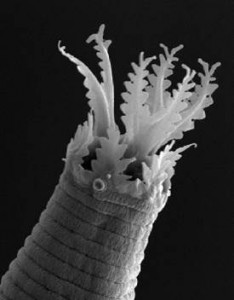
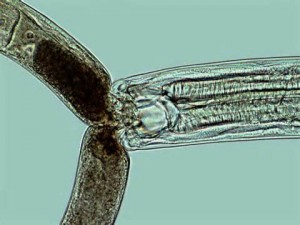
The rhizosphere of roots is typically dominated by bacteria or fungi (also protozoans). In annual cropping systems, bacteria are dominant in the rhizosphere and colonize the surfaces of roots. In perennial systems, especially those where trees are dominant, fungi can dominate although bacteria are common in these habitats also. Therefore, the types of beneficial nematodes found in these habitats will differ.
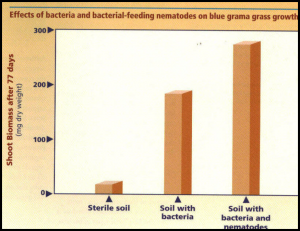
Plants grow better in the presence of beneficial nematodes. This is due to the fact nematodes must excrete excess nitrogen from their bodies and it’s usually in the form of ammonia. Since nematodes feed on bacteria colonizing the surfaces of roots, ammonia is released right in these areas making it readily available to plants. This constitutes a more effective way to feed plants instead of dumping nutrients into the soil at one or two times during a growing season. It’s similar to the way mineralization occurs after growing a legume and why these plants provide nitrogen credits; nutrients are pulsed into the soil over an extended period of time. Feeding plants steadily are more optimal than giving them large amounts of nutrients infrequently. This is probably true for almost any living organism.
Most beneficial nematodes are found in the “O” horizon of the soil where the majority of the microorganisms are found. As a general rule of thumb, the abundance of microorganisms decreases as soil depth increases. Cover crops are often used to increase numbers of beneficial organisms because the evidence is quite conclusive that as soil organic matter increases, biological abundance and diversity follows suit. Think of growing cover crops as providing food for your friends.
Soybean Cyst Nematode
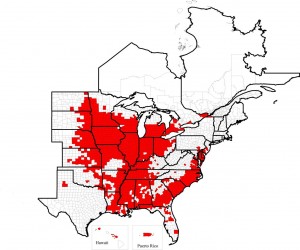
The soybean cyst nematode (SCN) is the most important pathogen of soybeans wherever it exists. SCN infests 40 counties in MI and about half of our soybean acres. Losses due to SCN in our state probably exceed $40,000,000. To maximize yields of soybean, SCN needs to be properly managed. This is typically achieved by growing non-host crops, including cover crops, in rotation with SCN-resistant soybean varieties.
Cover crops used to reduce population densities of SCN would be considered pest starvers or pest gassers. Pest starvers are essentially non-host crops, plants or cultivars on which SCN will not feed. All plant-parasitic nematodes are obligate parasites. They need living host tissues at some time in order to grow and reproduce. Without hosts, they will die although in the case of cyst nematodes they can persist 10-12 years in the absence of host crops. Up to a decade is required to “starve out” cyst nematodes.
Most species of plants used as cover crops are pest starvers for SCN. Hairy vetch should be avoided. It appears SCN will develop on crimson clover. But, in general, alfalfa and other species of clovers appear to be non- or very poor hosts for SCN.
Pest gassers are plants that once incorporated into the soil release gasses that can kill soilborne plant pathogens. These plants are typically brassicas/mustards as they contain glucosinolates (substances that give these plants their bitter tastes). Plants with glucosinolates or other similar compounds can be used as biofumigants to control nematodes. Green manure is incorporated into the soil and the breakdown products act as respiratory poisons to kill nematodes. Glucosinolate concentrations peak at particular times in plants (i.e., for oilseed radish during the green pod stage), so to maximize biofumigant effects, chopping and incorporation should be done at these times.
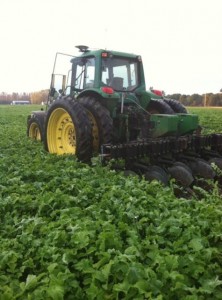
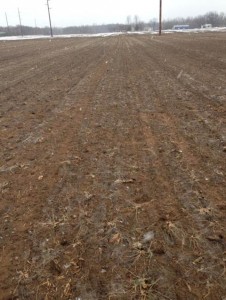
Pest gassers, such as mustards, fodder/oilseed radishes, and rapeseed, can be used to control SCN. However, they are all non-host crops and it is largely undetermined at this time if any additional control is achieved by using these plants as pest gassers. In general, in MI, biofumigation has not been proven effective against many types of plant-parasitic nematodes important in our agroecosystems.
No cover crop species/cultivars that function as pest trappers have been identified for SCN. Highly effective SCN-resistant soybean varieties function in this manner.
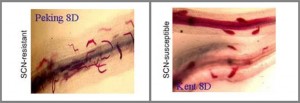
Beet Cyst Nematode
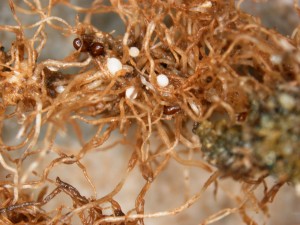
The beet or sugarbeet cyst nematode (BCN) is a major limiting factor in sugarbeet production in MI. Recent surveys indicate it infests about 25% of our sugarbeet acres and typically causes yield losses of 5-10 tons/A. These losses amount to more than $5,000,000 annually due to BCN.
BCN is typically managed by rotating non-host crops and/or cover crops that function as pest trappers or non-host crops with BCN-tolerant/resistant sugarbeet varieties. Some cultivars of fodder/oilseed radish are very effective pest trappers for BCN providing beet growers a tactic not available to soybean farmers battling SCN.
Beet growers wanting to reduce the impacts of BCN need to choose their cover crops wisely. Brown and yellow mustards, oilseed radish cultivars Ground Hog and Pile Driver (among some others), rapeseed cv. Dwarf Essex and fodder turnip need to be avoided if reducing BCN population densities is necessary for increasing beet yields. Most oilseed radish cultivars tested served as somewhat effective pest trappers against BCN with Defender and FumaRad rating highly effective.
Hosts for BCN are largely in the brassica family although some occur in other plant families. Grasses are non-host crops and should function as pest starvers. Many of the species that function as pest trappers also can be used as pest gassers against BCN but it is largely not known how much additional control is achieved using them for this purpose.
Northern Root-knot Nematode
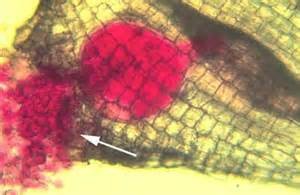
Northern root-knot nematodes (NRKN) are important pathogens of fruit, landscape/nursery and vegetable crops in Michigan. They also parasitize many row crops but losses on these plants due to NRKN are usually minor. Many vegetables are extremely susceptible as just the detection of NRKN in a soil sample is a concern for carrot growers where qualitative losses can exceed 50% in infested fields. Nurseries often suffer significant losses as reports of 75-100% culled daylily roots have occurred due to NRKN infestations.
Grasses are non-hosts for the NRKN. All dicotyledonous plants should be considered hosts unless they have been screened against these nematodes and reported as non-hosts.
The question is often asked, “How long should I grow a cover or rotational crop to control nematodes?” This could be expanded to include below damaging levels. The answer to this question generates two new questions. 1) How quickly do the nematode species present decline under a non-host or poor host? 2) How susceptible is the main crop(s) to the nematode species? Root-knot nematodes do not possess extended survival stages like cyst nematodes so typically a year or two of a non-host should be adequate to reduce their population densities below damaging levels. The initial population density plays a role in this decision. The more nematodes present, the more time out required. The susceptibility of the main crop is critical to address. Carrots are very susceptible to NKRN, so ideally they are below detectable levels prior to growing this crop. Soybeans, for instance, will tolerate some feeding by NRKN so it is not necessary to drive their numbers so low. Of course, to assess NRKN (as well as all plant-parasitic nematodes) population densities, it is necessary to collect soil and root samples and have the samples processed in a Nematode Diagnostic Lab such as the one at MSU. As a rule of thumb, the more susceptible the main crop is to a particular species of plant-parasitic nematode, the more time recommended in a non-host crop.
Many kinds of grass (Poaceae) are utilized as cover crops and they are the best choices if a major objective is to manage NRKN. They work as pest starvers. African and French marigolds are also effective pest starvers even though they are dicots. Arugula is also reported as very poor host but be sure it is not blended with mustards if it will be used for NRKN management. As mentioned previously, if the management of NRKN is imperative, most dicots should be avoided.
Plant species that are most often employed as pest gassers are good to excellent hosts for the NRKN. They really should be avoided. Edible radish can be used as a pest trapper for NRKN but very careful monitoring of the nematodes within root tissue is imperative if this tactic is to be used effectively. Radish can go from seed to harvest prior to NRKN going from egg to egg. However, if the radishes are left in the ground too long, NRKN females will produce eggs and the trapping is inadequate. The roots must be removed from the soil prior to any egg production for this type of trapping to be efficient. The trapping works only if the radishes are harvested prior to egg production because the nematodes are “trapped” within the roots and are then physically removed from fields.
Lesion Nematodes

At least 4 species of lesion nematodes exist in Michigan, but Pratylenchus penetrans is the dominant species. This nematode is widespread around the state and can be found in practically all of our ag sites. As an estimate, lesion nematodes infest 3 out of every 4 fields in our state.
Lesion nematodes are important plant pathogens because they cause disease but they also predispose plants to invasion by other plant pathogens. Potato early-dying disease is an example where lesion nematodes interact with the vascular wilt, fungal pathogen, Verticillium dahliae, often resulting in significant yield losses (up to 100 cwt/A). In black root rot of strawberry, lesion nematodes interact with Rhizoctonia solani to significantly shorten the life of strawberry plantings. The ability to wound roots and predispose them to other pathogens is an underrated and probably undiagnosed consequence of lesion nematode infestations.
In addition to being the most frequently detected type of plant-parasitic nematode in Michigan, lesion nematodes also have extremely wide host ranges. It is virtually impossible to rotate away from these nematodes. Therefore, very few pest starvers have been identified.
African and French marigolds and pearl millet (cv. HGM 100) are very poor hosts for lesion nematodes. Sudax is a poor to moderate host as well as Saia oats. Plants used as pest gassers and pest trappers against other nematodes typically are good to excellent hosts for P. penetrans. This is probably the most difficult nematode to manage with cover crops because choices are limited.
American Dagger Nematode
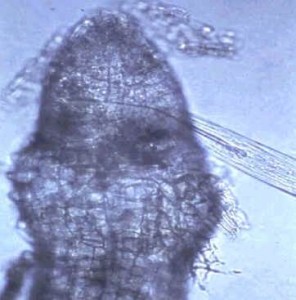
The American dagger nematode is, by far, the most common species of dagger nematode found in our state. It may prefer perennial cropping systems over annual ones as it is not favored by disturbance. The American dagger nematode causes diseases of many plant species but it is more important because of its abilities to vector plant viruses, most notably the tomato ringspot virus. Tomato ringspot is the most important virus transmitted by nematodes on fruit in North America. The virus is much more debilitating than the nematodes sans virus often shortening the productivity and lives of fruit trees, blueberry, and raspberry.
Most plant-parasitic nematodes survive as adults for only a few months but dagger nematodes can live up to two years or more. Understanding this aspect of their life histories is important when making decisions about their management. When attempting to reduce population densities of dagger nematodes using cultural tactics, at least two years of a non-host plant species is required to bring them to non-detectable levels.
Another approach is to limit their abilities to acquire viruses. Tomato ringspot virus is harbored by some broad-leafed weeds most notably dandelion. When establishing a stand of a cover crop, excellent weed control is imperative especially in cropping systems where fruit will be grown. However, this is really true of all cropping systems because many weeds are good to excellent hosts for the other species of plant-parasitic nematodes covered in this publication. But, since dandelion is a carrier for the tomato ringspot virus, it is critical this weed is controlled in future fruit plantings.
Rapeseed, cv. Dwarf Essex, is a pest starver and pest gasser for the American dagger nematode. It is also possible that oilseed radish is effective too but this has not been documented.
Grasses are good hosts for the American dagger nematode. However, grasses are pest starvers for the tomato ringspot virus. If grasses are grown for two or three years prior to the establishment of a blueberry or raspberry planting, orchard or vineyard and good dandelion control was achieved, the impact of the virus should be mitigated. Although tomato ringspot virus particles line the esophagus of dagger nematodes and are thus transmitted, the virus cannot be passed along to the offspring through eggs; it must be acquired by feeding. Therefore, although the population densities of dagger nematodes will not be reduced by growing grasses, the tomato ringspot virus can be eliminated from the nematodes if all the adults succumb. In this case, the purchase of virus-free planting stock is critical (as it always should be) because the dagger nematode vectors still exist in these locations.
The Corn and Common Needle Nematodes

Michigan is home to at least two species of needle nematodes, the corn and common. The corn needle nematode is a very destructive pathogen of the crop and can reduce yields up to 50 bu/A. It is infrequently detected due to the fact it thrives best in sites with sandy soils (>70% sand). The common needle nematode is found more frequently as it is associated with many vegetable crops as well as fruit. It too is a very destructive pathogen.
Needle nematodes, similar to dagger nematodes, do not like disturbance. Needle nematodes can also potentially vector plant viruses although no viruses transmitted by these nematodes are of importance in Michigan. Needle nematodes can survive long periods without food as they often aestivate during the summer.
Legumes can be utilized as pest starvers for corn needle nematodes. Brassica crops can be utilized as pest starvers and pest gassers. Good grass control is critical because grasses are hosts for corn needle nematodes. Soybean is a good rotational crop.
The common needle nematode has an extremely wide host range and may maintain its population density on a variety of plant species. Not much has been reported on the uses of cover crops to manage this nematode. But, brassicas/mustards and legumes should be effective.
Conclusions
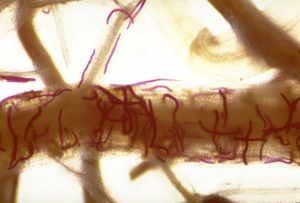
Although the management of seven species of nematodes using cover crops was covered in some detail in this publication, many other nematodes exist in Michigan and are quite common. The seven covered are arguably the most destructive based on their yield loss potentials. However, lance, stem and stubby-root nematodes are also potentially very damaging nematodes. They should not be ignored.
Most fields are infested with two or more species of plant-parasitic nematodes. It is important to have the nematodes identified and focus management efforts on the one(s) considered the major limiting factor. Unfortunately, when cover crops are used, one species of nematode may be favored while another declines. Once again, it is important to remember, not all nematodes are the same.



 Print
Print Email
Email



